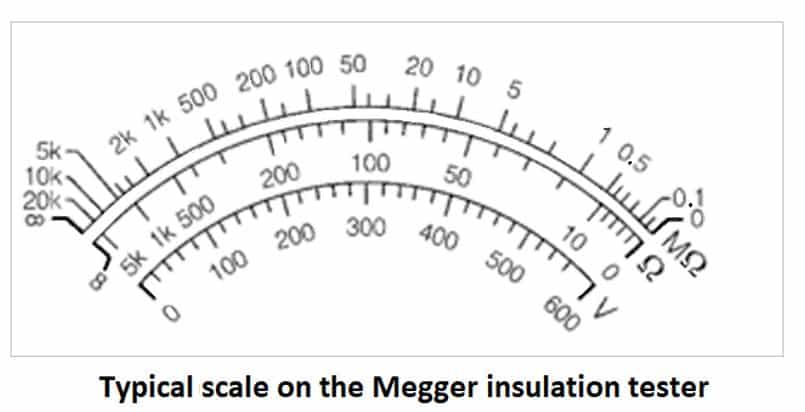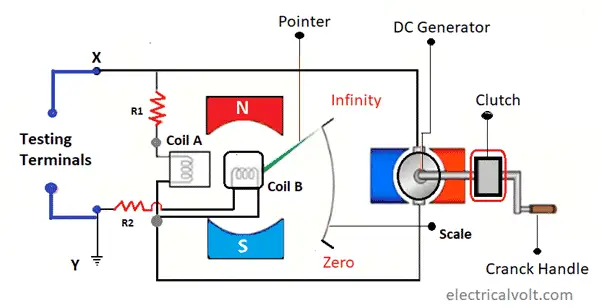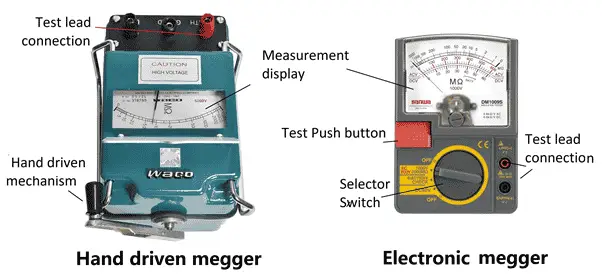The term megger or megohmmeter refers to an instrument for measuring high voltage electrical insulation. “Megger” is the brand name of the first portable insulation measuring instrument. Also, insulation resistance tester known as megger is small in size, portable and popular
The name of this instrument, megohmmeter, derives from the fact that the measurement of insulation of cables, transformers, insulators, etc is in megaohms (MΩ). Thus , the megger can measure the insulation resistance in order of megaohms.
Hence, It is not correct to use the term “Megger” as a verb in expressions such as the “cable must be meggered”. The megger measures the resistance in the range of zero to infinity. Initially, the pointer is at the infinity position.

Purpose of Insulation Resistance Test
The main objective of use of the megger is to analyze and correctly apply the insulation tester in the evaluation of the insulation level in equipment and electrical installations according to the standard. Therefore, it is mandatory to check the insulation resistance before charging of electrical equipment.
The purpose is to check the integrity of both the conductors and the insulators. In this way, it is possible to minimize the the possibility of a short circuit or a ground fault. Otherwise, this may result in a danger of death for users or even an electrical fire hazard in the installation itself.
What does Insulation Resistance mean?
Insulation resistance is the resistance in ohms of electrical wires, cables, and equipment. Insulation serves to protect electrical systems such as electric motors from any accidental damage such as electric shock or sudden discharge caused by leakage of current in the wires. There should be no voltage in the circuits whose insulation resistance to be measured.
There are two ways by which we can measure the insulation resistance.
Type 1 measurement: Between power supply conductors connected concerning ground.
Type 2 measurement: Between each pair of active conductors.
The analysis of the integrity of the electrical insulation is a common practice within electromechanical maintenance tasks, as a preventive and predictive measure. Thus, It is not possible to judge the equipment health without taking the insulation resistance,
Working Principle of Megger
Megger operates on the principle that current flowing through a conductor placed in a magnetic field experiences a torque. Mathematically, the force is proportional to the current and the magnetic flux.
Where, Vector Force = force and direction of the current and magnetic field.
Case (I): If the resistance has a higher value then the pointer on the device coil will move towards infinity.
Case(II): If the resistance value is low then the pointer will indicate zero resistance.
The comparison between the known resistance and insulation resistance shows the condition of insulation quality. Compared to the other electrical measuring instruments, Megger provides the highest measurement accuracy.
Why Insulation Resistance Test?
There are various applications in which electric motors operate in adverse conditions.
Due to humid environments, high temperatures, poor ventilation, reflected wave effects in power wiring, contaminants in the air, and inherent contaminants of the process of which they are part. All of these conditions have an impact on the performance and life of the motor’s electrical insulation.
Megger Construction
The Megger is useful for measuring a high resistance value. It has the following parts.
- DC generator
- Two coils. They are coil A and coil B.
- Clutch
- Crank
- Terminal X & Y.
Construction of Megger
A Mggger has a crank shaft with clutch mechanism. We can vary the speed of cranking with a help of clutch. This arrangement is located between magnets. The whole setup is called DC Generator.
On the left side of the DC generator, there is a scale showing the resistance values from 0 to infinity.
The circuit consists of two coils Coil-A and Coil-B. Both the coils are connected to the DC generator

The connections of test terminals X and Y are as follows.
To calculate the transformer winding resistance, then we connect the transformer winding between the two test terminals X and Y.
If we want to measure the cable insulation, then the cable is connected between the two test terminals A and B.
Procedure for Testing Insulation Resistance
First, connect the probe of Megger one to the Line(R), and the other to the ground. After connecting the probes press the electronic megger TEST push button. If it is manual megger, rotate the cranking shaft.
Now, repeat the above process by connecting the megger probes to the other lines Blue (B) and then Yellow (Y), and check the insulation resistance value.
Thus, we can find the insulation resistance by connecting the megger leads between the motor ground terminal and individual windings R, B, and Y separately.
As described in Megger’s principle above, if the resistance in megger indicates infinity, then the motor status is in good condition. The zero resistance indicates a short circuit of winding with body, which indicates bad insulation. Also, the low value resistance shows deterioration in insulation quality.
Types of Megger
There are two types of megohmmeter,
- Manually driven megohmmeter
- Electronic megohmmeter

Manual megger
It is a hand-operated and cranked manually type megger. Manually operated type megger has important parts such as an analog display, hand crank, and test lead wires.
Electronic megger
It is battery-operated. It has important parts such as a digital display, lead wires, and a selection switch. The digital display displays the IR value. Additionally, megger has a selector switch. The selection switches select the range of electrical parameters, and the indicator shows the status of the parameters.
Precautions while doing Megger test
- Never touch the leads while doing an insulation resistance test with a megger.
- Damaged insulation may cause arcing, therefore, it is not advisable to perform insulation resistance in an explosive atmosphere.
- For safety and convenience in the measurement, the measuring instrument should have an automatic circuit discharge function at the end of each test. Even if the megger has the automatic discharge circuit, we must discharge it manually for safety reasons.
- Only the authorized or competent person must carry out the insulation resistance test because this process comprises risk.
Advantages of Megger
- Measurement accuracy is high.
- Its operation consumes less time.
- Megger consists of a permanent magnet DC Generator (source of supply), useful for numerous applications. It is useful for measuring the resistance of insulators accurately.
- The megger value shows the insulation damage. Thus, it is possible to identify poor or defective insulation.
- The megger can measure the resistance in the range of zero to infinity. Thus, it has wide applications in measuring IR value of cables, motors, transformers, generators any almost every electrical equipment.
Disadvantages
- There will be an error in reading the value when the external resource has a low battery, sensitivity error.
- Error due to temperature change.
- Testing with Hand-driven megger requires two persons. One for cranking and the other for testing. Thus, it requires more resources.
- Accuracy of hand-driven megger is less. The test voltage is not constant in hand driven megger because the speed of cranking changes.
Applications
- The electrical resistance of the insulator can be measured.
- Electrical systems and components can be tested
- Winding Insulation testing, continuity testing
- Battery test, relay, ground, etc.
Read More:
Simple to under stand.
Fine.
What will happen, If we use a 5KV hand cranking megger, For testing a 250 Volts home wiring?
The voltage produced by cranking megger depends on the speed of crank rotation. You may check and ensure before taking IR value the cranking speed at which the voltage produced by megger is 250 volt. Then, the same 5kV megger can be used. Never feed more than the rated voltage of the equipment for IR testing, else equipment will get damaged.